Prostatitis isa purely male disease. This is one of the most common lesions of the genitourinary system and occurs in about 80% of men, of which 4 cases occur before age 40.
This disease is not an isolated process: itdamages nearby organs and poisons the entire body.
How does prostatitis develop?
The essence of this process is prostatitis or prostatitis.
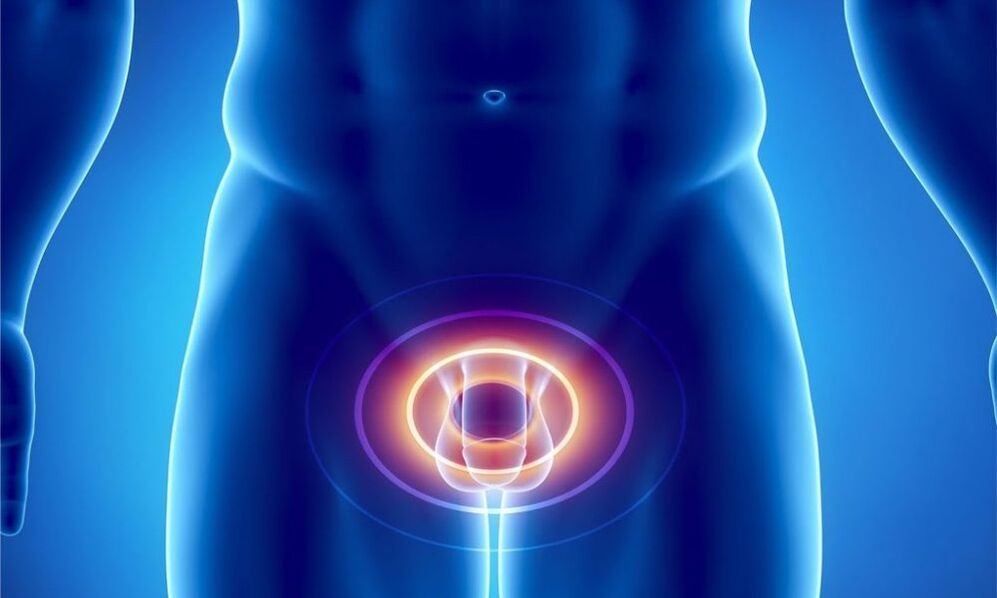
The prostate is located in the pelvis, close to the base of the bladder. This is an unpaired organ that looks like a chestnut. The urethra passes through it. Behind the gland is the rectum, in front is the pubic bone.
The prostate is a fairly elastic organ because its base is made up of muscle fibers and glandular cells. It consists of 2 lobes, connected by an isthmus. This is the main source of problems related to urination. Densifying and increasing in size with age, the isthmus puts pressure on the urethra, disrupting urine excretion.
Prostateperform those functions for the body:
| Function | Nature |
|---|---|
| secretary | Produces a secretion that is part of sperm. It dilutes it, establishes the necessary pH level and increases sperm motility. |
| Engine | The muscle fibers of the gland form the urinary sphincter, which helps retain urine. |
| Fence | Contains a zinc-peptide complex, lysozyme, cellular immune factors, spermidine, which prevents the development of infections in a progressive manner. |
Prostatitis develops when an inflammatory process begins in the gland. At the same time, it increases in size, compressing the urinary tract. This makes it difficult to urinate.
In addition, the enlarged prostate also "invades" the bladder, compressing it. Because of this, the process of draining urine from it is interrupted, it stagnates, causing cystitis. Long-term stagnation of urine in its "reservoir" leads to poisoning of the entire body with metabolic products contained in its composition.
Contributing factors
The main reason for the development of prostatitis isinfection. These can be staphylococcus, enterococcus, Klebsiella, Pseudomonas aeruginosa and Escherichia coli, Proteus. Most commonly, prostatitis isconsequences of sexually transmitted diseases: syphilis or gonorrhea, chlamydia, trichomonas.
Less commonly, the cause of the disease isinfection of other systems: flu, tuberculosis, tonsillitis and other diseases. Bacteria and viruses enter the prostate through the lymph and bloodstream, as well as through sexual intercourse. Quite often, pathogenic flora is introduced into the gland through the ascending route from the urethra or descending from the bladder with infected urine.
Other factorsCauses of glandular inflammation include:
- circulatory disorders in the pelvic area. This can be due to a sedentary lifestyle, being overweight and pelvic injuries. A special risk group is represented by drivers who are constantly in a sitting position and experience vibration and pressure on the perineum. Reduced blood circulation in the pelvic region causes congestion and lack of oxygen in the prostate, which also causes the development of infection,
- Hypothermia,
- hormonal imbalance,
- problems with urination,
- Irregular sexual activity – sex life is too "violent", abstinence, interruption of sexual intercourse,
- chronic constipation,
- proctitis,
- reduces immunity, due to which the body becomes sensitive to infectious agents.
It has been suggested that the risk of developing the disease increases with regular use of alcohol and drugs.
Classification and symptoms of the disease
In the modern world, the division of prostatitis into types is carried out according to the 1995 classification of the US National Institutes of Health. Itbased on clinical data, as well as the presence of leukocytes and pathogenic microflora in semen, prostatic secretions and urine:
- Acute bacterial prostatitis.
- Chronic bacterial prostatitis.
- CPPS – chronic pelvic pain syndrome or chronic nonbacterial prostatitis.
- Asymptomatic prostatitis.
Acute prostatitisis infectious. There are several stages:
- inflammatory bowel diseaseAccompanied by frequent and painful urination. The pain spreads to the sacrum and perineum,
- egg follicles. The intensity of the pain increases. It also appears during defecation. Urinating becomes difficult - urine flows out in streams or thin drops. Increased body temperature up to 38°,
- parenchyma.Characterized by acute urinary retention and bowel motility problems. Severe pain in the perineum, lower back and above the pubic bone. Body temperature increases to 38-40°. The body is poisoned, the symptoms are general weakness, nausea and increased heart rate.
When digitally examined by a urologist, the prostate is felt to be enlarged, dense, hot, and painful to the touch. A large number of white blood cells and bacteria were detected in the urine.
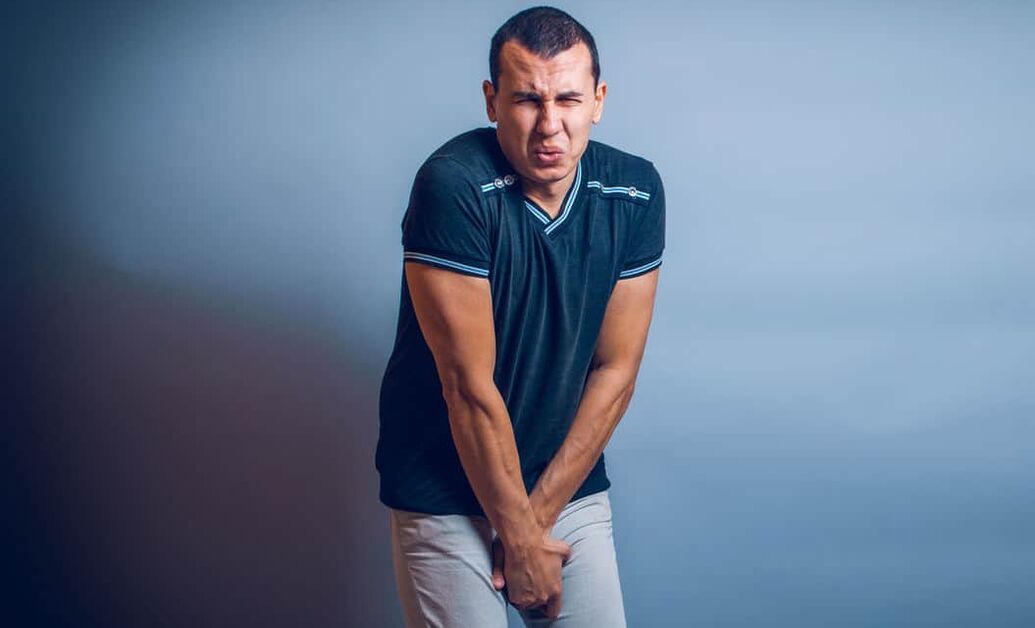
Chronic prostatitismay develop as a consequence of an acute illness or as a separate disease. Diagnosis is made if the process lasts 3 months or more.
Chronic prostatitis manifests in 3 main syndromes:
- painful.Interestingly, the prostate itself does not contain pain receptors. Pain appears when the inflammatory process invades the nerve fibers of the small pelvis, of which there are quite a few. It has a different nature. It can be insignificant or sharp and strong, causing discomfort even at night, gradually decreasing and then resuming. It is localized in the sacrum, scrotum, lower back and perineum.
- difficulty urinating.The urge to urinate becomes more frequent. It becomes sluggish and there is a feeling of a heavy, not completely empty bladder. The process may then improve due to a compensatory increase in the bladder muscles, but will soon resume again. Secretion appears from the urethra during bowel movements.
- sexual disorders– increase or decrease in nighttime erection, blurred orgasm, pain during ejaculation and its increase. Sexual dysfunction worsens, eventually leading to impotence. There is a concept of psychosis, when a man convinces himself that in his condition, violations in the intimate sphere are inevitable. And they are really growing. With the development of sexual dysfunction, a man's mood also changes: he becomes irritable and depressed.
Often, the chronic form of prostatitis becomes a manifestation of underlying sexually transmitted diseases.
Diagnosis of CPPSplaced if there are clinical manifestations of prostatitis but pathogens of the disease are not detected in biological fluids (urine, ejaculate and prostatic secretions). Leukocytes were determined at the same time.
The main criterion for diagnosis is that the pain does not decrease within 3 months.
Chronic pelvic pain syndrome is divided into two types: inflammatory and non-inflammatory.
CPPS inflammationidentified when a large number of leukocytes are found in biological fluids. Bacteria were not detected.
CPPS is not inflammatoryis characterized by the absence of leukocytes and pathogenic flora in biological fluids.
In both cases, prostatitis symptoms persist.
Asymptomatic formThe disease is characterized by the absence of signs of prostatitis. It is discovered incidentally during histology of prostate tissue if the patient is referred for prostate biopsy. A similar procedure is prescribed, for example, when the PSA level increases.
Diseases, regardless of type (except asymptomatic forms), have manifestations, first of all urinary disorders:
- pain when urinating,
- weak or dribbling urine stream,
- feeling that the bladder is not completely empty.
If such symptoms appear, do not delay visiting a urologist. This will help stop the process at the first stage.
How to recognize the disease
The main criteria for diagnosis are the clinical picture and patient complaints.
But finally to confirm it,need to go through a series of tests and examinations:
- Examination by a urologist. The doctor must perform a rectal examination of the prostate. It is inserted with a finger through the rectum. You should have a bowel movement before the examination. Using manipulation, the shape and size of the gland as well as its consistency are determined. This procedure helps determine the presence of tumors and inflammation in the prostate. Digital examination allows you to collect prostate secretions.
- Urine analysis.Two parts are tested: urine collected at the beginning of urination and urine collected at the end of the procedure. 1 serving indicates the condition of the urethra, 2 – kidneys and bladder. The presence of white blood cells in the urine above the normal level (15 per field of view) indicates inflammation.
- After collecting urine, prostate massage is performed, thereby obtaining its secretion.If there is too little and it does not exit the urethra but remains on the urethral wall, the urine is collected after massage. It has as much information as the prostate secretion itself. Here, leukocytes (cannot be more than 10) are also identified, in addition to lecithin granules and amyloid bodies. If the first analysis of the secretion of the gland does not show any abnormalities, this does not mean that there are no processes. Prostatic fluid may be too viscous and block the ducts of the affected glands. Then the secretion will be produced by healthy glandular cells. Therefore, such analysis must be performed multiple times. Cultures of urine and prostatic secretions were also performed to identify the causative agent and determine antibiotic sensitivity.
- General blood analysis.
- Analyze the presence of sexually transmitted diseases.
- Ultrasound of kidneys, bladder, TRUS,allows you to thoroughly assess the condition of the prostate,
- Measure urine flow.It is used to evaluate the rate and duration of urine excretion. It is done with a special device consisting of sensors and containers. All the patient needs to do is urinate into it in the usual way.
- Blood PSA- Prostate specific antigen. It is an indication of the presence of a tumor in the prostate - adenoma or cancer,
- Prostate biopsy.It is performed if the presence of cancer is suspected.
Sperm imaging is required, which will help confirm or refute infertility.
Treatment of acute and chronic prostatitis
Uncomplicated acute prostatitis is usually treated on an outpatient basis. Hospitalization is indicated when intoxication is severe or complications develop.
Treatment of acute prostatitisStart with antibiotics. If the condition is strongly disturbed, they will be performed without waiting for the results of the analysis. They use groups of antibacterial drugs that are able to penetrate deep into the tissues of the prostate. They act on the bacteria that most commonly cause inflammation. These antibiotics include fluoroquinolones.
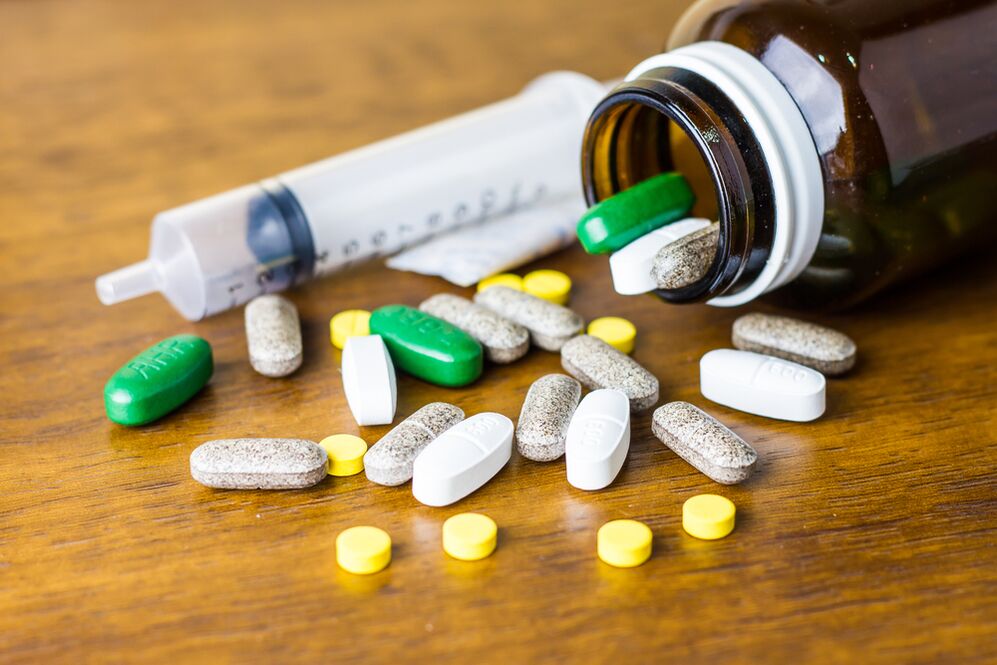
When you receive your testAntibiotic therapy can be adjusted differently. It all depends on the pathogen and its sensitivity to the drug. Therapy is also changed if no effect is seen after 2 days.
In cases of acute prostatitis, the use of analgesics as well as nonsteroidal anti-inflammatory drugs is indicated. In addition to oral medications, suppositories are also used, which also have analgesic and anti-inflammatory effects: based on prostaglandin extract, suppositories contain propolis.
In case of severe poisoningperform detoxification therapy. To do this, use a glucose solution.
Prescribed medication helps improve blood circulation in the prostate. They ensure lymphatic drainage from the gland, reduce swelling and promote the elimination of toxins.
In cases of acute prostatitis, it is forbidden to massage the gland as this can cause sepsis.
Treatment of chronic prostatitis depends on the stage of the disease.
In acute form, antibiotics are used. During the remission phase, therapy is aimed at maintaining the normal functioning of the gland:
- The drug normalizes the microcirculation of the organ.
- Anti-inflammatory drugs.
- It is important to maintain the body's immune function, which is reduced by antibiotic treatments. To do this, the patient is prescribed immunostimulating drugs.
- For sexual dysfunction, antidepressants and sedatives may be prescribed.
- Prostate massage.
- Physical therapy:
- lasers,
- supersonic,
- rectal electrophoresis,
- Transrectal microwave hyperthermia.
- Physical therapy.
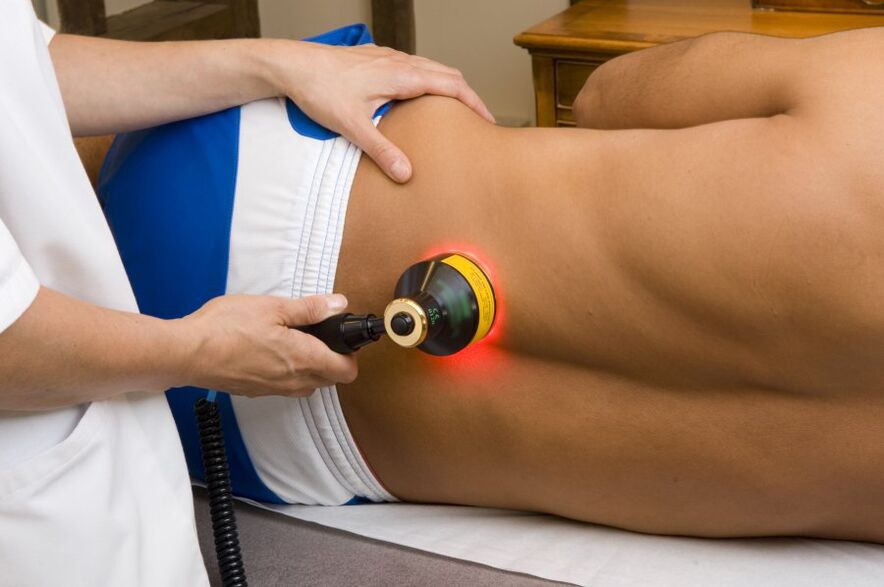
Physical therapy for prostatitis helps increase the tone of the pelvic floor muscles and reduce pain.
Prostate massage: purpose and technique
Finger massage of the prostate has several purposes.
It is used as a diagnostic, to obtain glandular secretions and also as a treatment for chronic prostatitis.
Most ofA common method for this procedure is transection. In this case, the patient is placed on his right side with his knees bent. The doctor inserts his index finger into the anus, moving it along the rectum. Then perform massage: gently stroke each lobe of the gland around it and along the ducts. At the end of the procedure, the groove between the lobes is kneaded to release secretions.
It is necessary to focus on the patient's feelings: do not cause pain during manipulation. The procedure lasts 1 minute, the entire course is 15 sessions.
A sign of high-quality massage is the release of a few drops of glandular secretions.
Such manipulation first of allincreases blood circulation in the prostate. This speeds up tissue repair and improves drug delivery, eliminating blockages and reducing inflammation.
Massage helps strengthen the muscles of the glands and perineum. This procedure allows you to remove stagnant semen from the organ, thanks to which the prostate is cleansed of bacteria and toxins. Urethral compression is eliminated and urination improves. Massage increases potency by increasing semen circulation.
In addition to the transrectal method, there is also a method of compressing and massaging with a flower bouquet.
Dropping methodStart by inserting the drug solution through the urethra. It is then clamped and the prostate is massaged using the finger method. In this case, the healing solution will penetrate into the gland, improving the effectiveness of the procedure. Finally, the urethra is clear, so wait a while before urinating. The medicine is reintroduced into the urethra.
Massage Bougieis performed through the urethra using a bolus - a special instrument for dilating and examining tubular organs. The patient is in the right lateral position. The bougie is inserted into the urethra and held with one hand. Use your second hand to stroke and press the penis from top to bottom. The duration of the procedure is 1 minute, after which the drug is injected into the urethra. This massage is supported by antibiotic therapy.
Prostate finger massage– medical manipulation, performed by a specialist according to clear indications.
There may be an option for self-massage: to do this, rhythmically tense and relax the muscles around the anus. This procedure will be invisible to others and will help strengthen the gland.
Like any manipulation,Prostate massage has contraindications:
- acute prostatitis,
- cancer or adenoma of the gland,
- hemorrhoids,
- stones, cyst formation in the prostate organ.
A professionally performed procedure will help restore the structure and function of the prostate, and stimulation of sensitive points will eliminate sexual dysfunction.
Prostatitis and traditional medicine
Along with medications, traditional methods will also help to cope with prostatitis.Combine these two treatment methods, you will accelerate the healing process and get rid of unpleasant sensations.
There are many home recipes that help fight prostatitis. Here are some of them:
- Grind 500 grams of peeled raw pumpkin seeds through a meat grinder and mix with 200 grams of honey. Make small balls from the resulting mass. Use before meals twice a day, chew slowly, dissolve completely. Pumpkin seeds contain large amounts of zinc, which is essential for men's health.
- Blueberries have anti-inflammatory effects. By eating 200 grams of these berries every day, you will support your male health,
- First of all, parsley has become famous as a culinary spice. But besides that, it also contains many useful substances, including those that the male body needs. Take 1 tablespoon parsley juice. I. 3 times a day 30 minutes before meals. This will help reduce inflammation and improve sex life,
- Take the green shell of the chestnut along with the spines, cut it into small pieces and pour boiling water over it. Used as tea
- Grind 300 grams of onion into a paste, add 100 grams of honey, 600 ml of dry wine. Leave for 1 week in a cool, dark place, stirring occasionally. Stress. Use 2 tbsp. I. 3 times a day before meals. Effective in the treatment of chronic prostatitis.
Some will help speed recoverydo exercise. They stimulate blood circulation in the pelvic area and, accordingly, in the prostate.
- Squat deep below the knees. The optimal number of repetitions is 100. Do it 3 times a week. If you can't do that amount at once, perform squats in multiple approaches with rest periods.
- Drag. Sit on the floor with your hands on the floor behind you. Stretch your legs forward, lifting them off the floor. Pass them together. The movements resemble the action of scissors.
- Lie on your back, bend your knees and bring them to your chest. Wrap your arms around them. Hold the pose for up to 20 minutes.
- Regular walking is also a great way to relieve congestion.
You canSupplement this complex with other exercises, helps activate and warm up muscles.
Prostatitis in adolescence
It's hard to believe, but prostatitis, once considered a disease of middle age and the elderly, is now significantly younger and is detected even in adolescents. It negatively affects the condition of the entire body, as well as the fertility of young people.
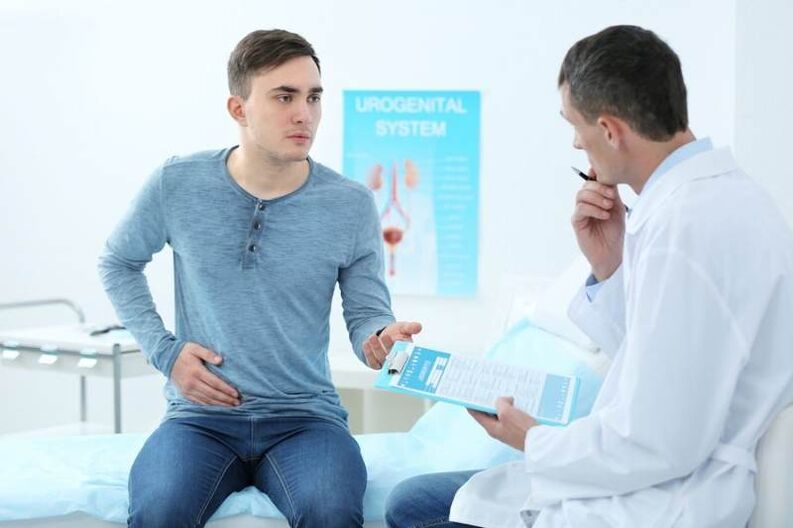
That's whyit's important to understand whyleading to prostatitis in adolescence:
- early sexual activity and sexual illiteracy.Unprotected sex contributes to an increase in sexually transmitted diseases, which can cause bacterial prostatitis,
- Hypothermia- a factor that contributes to the development of prostatitis. Temperature imbalance reduces immunity and makes the body susceptible to infection attacks,
- fashion trends– wearing clothes and underwear that are too tight will disrupt blood circulation in the pelvic area and lead to stagnation in this area,
- sedentary lifestyle– work on computers among modern youth replaces sports, walking and other active pastimes,
- excessive sexual activityliterally exhausts the gland. Its function is reduced, small amounts of secretions are secreted, and its quality is impaired, making it more susceptible to infection.
Prostatitis manifests itself in young people in different ways. Some are concerned about obvious symptoms: hyperthermia, severe pain in the groin when irradiating neighboring organs and when urinating. For others, symptoms occur in mild form. General weakness, decreased activity, mild fever and urethral discharge appear.
VeryIt is important not to ignore the signs of the disease, but to start treatment promptly.. A neglected pathological process will leave its mark on the condition of the young man's organs and life.
Preventive action
It is better to prevent any disease than to treat it. Measures to prevent prostatitis are quite simple and not difficult to implement.
- Firstly,Review your daily routine. If you have a sedentary job, be sure to include 5-minute exercise sessions in your routine. Stretch your body, move more. This is necessary so that blood "runs" faster through the blood vessels. At the same time, avoid excessive physical activity that exhausts the body.
- Quit smoking. Cigarette smoke constricts blood vessels and impairs blood circulation, reducing the amount of oxygen supplied to the prostate. Limit drinking alcoholic beverages.
- Avoid hypothermia and nervous tension.
- It is recommended to eat marinated dishes, as well as spices, pickles and hot sauces in moderation.
- It is necessary to regularly observe sexual activity and have full sexual intercourse.
Untreated prostatitis threatens a number of complications: transition to a chronic form, development of infertility, spread of the process to the kidneys and bladder. More serious consequences include adenoma and prostate cancer. It is possible that pockets of pus - abscesses - may appear in the gland and become infected.
As you can see, this disease is quite dangerous. And, despite the delicacy of the matter, you should not delay her treatment. Block this process in the early stages of its development: only in this case will you protect your health and vitality.

























